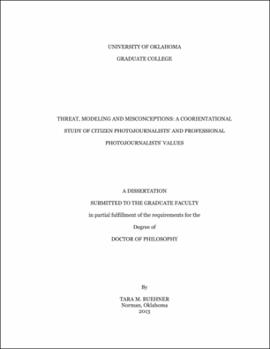| dc.contributor.advisor | Gade, Peter J | |
| dc.creator | Buehner, Tara | |
| dc.date.accessioned | 2019-04-27T21:37:21Z | |
| dc.date.available | 2019-04-27T21:37:21Z | |
| dc.date.issued | 2013 | |
| dc.identifier | 99354051102042 | |
| dc.identifier.uri | https://hdl.handle.net/11244/319187 | |
| dc.description.abstract | With the onset of digital technologies and the active audience it allots, professional photojournalists find themselves in competition with citizen photojournalists. The ability of citizens to create and publish their own photographic content, their advantage in right-place, right-time photography, and the interest of resource-strapped news organizations to publish these citizen photographs all lead to a probable tension and professional threat experienced by professional photojournalists. This tension between professional and citizen photojournalists is the subject of this dissertation. Specifically, the study uses coorientation theory to examine the journalism and photojournalism values that each group holds to, as well as their level of agreement with each other, their accuracy in assessing the views of each other, and the extent to which they perceive themselves as similar to each other. Further, a photographic analysis of news image quality with a manipulated credit line sheds line on whether professionals' threatened sense of professionalism impacts their assessment of citizen news photography. | |
| dc.description.abstract | This study finds that professional photojournalists and citizen photojournalists share some values, and in most cases, they share the same general attitude about journalism and photojournalism values, but they differ in the degree or intensity of their responses. Both groups are inaccurate in perceiving the attitudes of the other, but professional photojournalists are much less accurate than citizens. Likewise, both groups perceive themselves as different from the other group, but professionals view themselves as differing much more from citizens than citizens perceive themselves as differing from professionals. In some cases, citizen photojournalists perceive that professionals adhere more to the values of professionalism than themselves, but professionals perceive citizens as adhering to the values less. Finally, professional photojournalists evaluate a photograph that is credited to a citizen photojournalist significantly more negatively than they evaluate a photograph with no credit line, but citizen photojournalists show no difference in how they evaluate a photograph with a professional credit line and a photograph with no credit line. | |
| dc.description.abstract | This study suggests that professional photojournalists are experiencing a threatened sense of professionalism in the midst of citizen photojournalism. But citizen photojournalists demonstrate no sense of competition with professional photojournalists. Overall, there is much misunderstanding between the two groups, but professionals are more greatly misunderstanding of citizens. | |
| dc.format.extent | 334 pages | |
| dc.format.medium | application.pdf | |
| dc.language | en_US | |
| dc.relation.requires | Adobe Acrobat Reader | |
| dc.subject | Photojournalists | |
| dc.subject | Photojournalism | |
| dc.subject | Photography--Social aspects | |
| dc.title | THREAT, MODELING AND MISCONCEPTIONS: A COORIENTATIONAL STUDY OF CITIZEN PHOTOJOURNALISTS' AND PROFESSIONAL PHOTOJOURNALISTS' VALUES | |
| dc.type | text | |
| dc.type | document | |
| dc.thesis.degree | Ph.D. | |
| ou.group | Gaylord College of Journalism and Mass Communication | |
